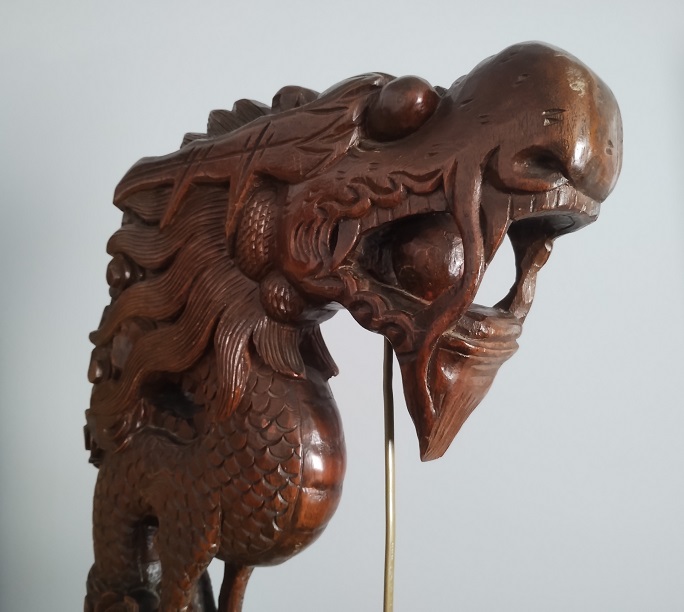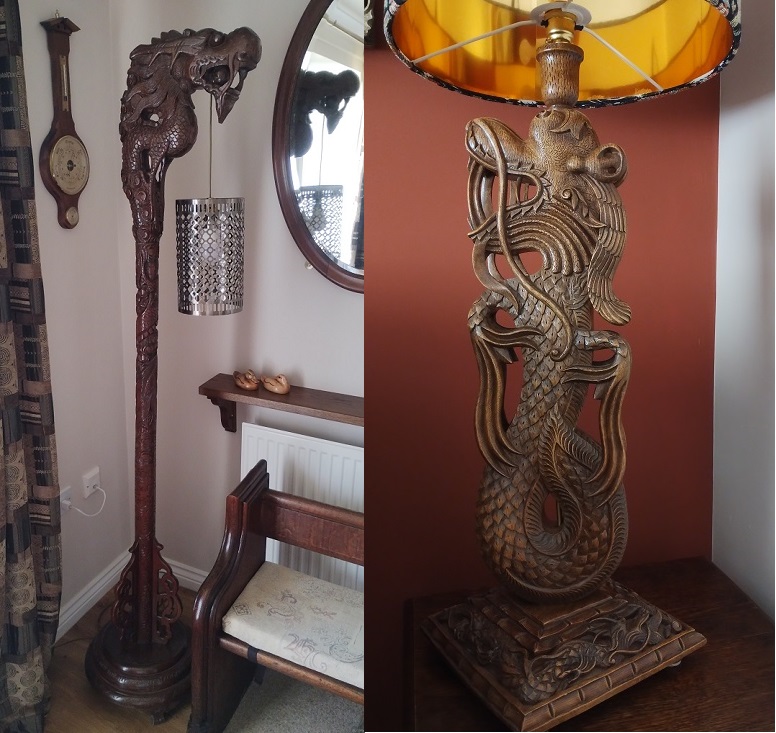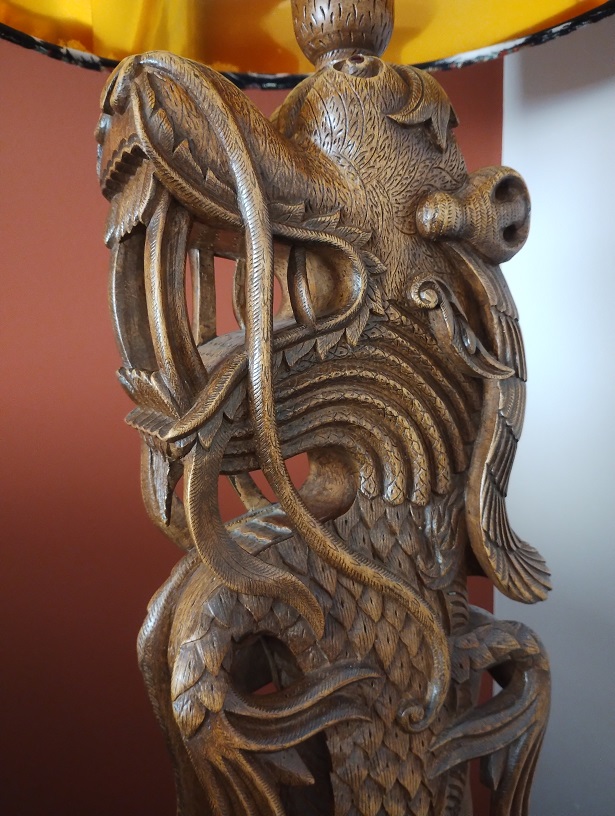We are the proud owners of two carved wooden “dragon lamps”. The larger of the two provides a very comforting presence in our hallway, particularly on dark winter evenings. The smaller one, sits on a low table in the dining room. Most evenings, I spend a little time reading in there, my book illuminated by the dragon’s light. Such is our affection for them, neither is ever likely to be catalogued for selling.

Whilst we purchased both lamps in Britain, that is only the latest chapter in their stories. If the dragons could talk, each would have a remarkable tale to tell. In this posting I’d like to share some thoughts as to how they came to be in Britain because there’s one thing I’m sure of, neither started life here.
Oriental trade gets steamed up
The British have been fascinated by the Orient for a very long time, none more so than in the 1930s. This was reflected in the growing Oriental collections accumulated not only by museums but by wealthy private collectors as well. Since at least the 18th century, Chinese ceramics had been coveted and collected by the increasingly wealthy middle classes. This continued through the 19th Century and into the 20th.
In earlier centuries Oriental ceramics were often transported as ballast in sailing ships whose principle cargo was tea. Tea Clippers as these ships were known were the cutting edge of ship design. They had to be as fast as possible because tea degraded quickly. The opening of the Suez canal in 1869 had a huge impact on East/West trade (reducing the journey by over 5000 miles).

At this time, long distance trade was still dependant on sailing ships which were in turn dependent on the winds and the seasons. This meant that only the most valuable cargoes would be transported long distances. Steam power was used in ships but only on shorter routes because of the quantity of coal required. By the 1930s there had been a gradual introduction of much more efficient steam power to ships, allowing them to sail long distances between coal stops. This brought about not just a rapid reduction in the use of sailing ships for bulk transport but also it greatly increased the volume of global trade.
Furniture is a great survivor
Huge quantities of tea and spices continued to be transported to Britain, but of course these leave little trace. Furniture and ceramics are a different matter. You can get a measure of how much Oriental furniture must have been imported in this period by searching across online auction catalogues such as easylive or the-saleroom. You’ll find a good range, much of which will be described as either late 19th or early 20th century. Whilst the cataloguing is often frustratingly vague both in terms of origin and date the items are almost all well made. Many of the smaller, portable items would have been made for export and today these are very reasonably priced.
As an aside, you’ll also find lots of beautifully made tea caddies from the same era!
Anyone can appreciate Oriental furniture
Whilst you might feel you need to be an expert to appreciate the finest 19th Century Oriental ceramics, anyone can be wowed by the furniture. Some pieces are too large for a typical modern home but smaller items such as tables, chests and plant stands are easily accommodated. The quality of manufacturing and the deep colour and patination of the wood make Oriental furniture a lovely addition to any home.
The one that got away
My introduction to Oriental antiques came through Mallams auction room in Cheltenham. At the time I worked in an office a few minutes walk away. I always took time out over lunch to browse their sales. Twice a year Mallams hold Oriental art sales which include some fantastic stuff. One of the first sales I viewed included two tall, wooden lamps with the tops carved into the shape of dragons. I’d never seen anything like them. Neither was in great condition but both were certainly restorable, even with my limited woodworking skills. When I saw the estimates below £100 each I was really excited. For the quality of carving and the appeal of the lamps I’d have guessed three or four times as much.
As often happens, auction day was a let down. I was completely out bid. Even the more rickety of the two lamps went well beyond where I was expecting to have to go. Not to be put off though, my initial failure just set me looking for more. What I found was that a search around the internet at any time will bring up one or two similar lamps for sale in Britain. I also found that yhey vary in quality and condition, so it pays to be patient.
A closer look at our lamps
It took us a couple of years but we eventually managed to purchase two dragon lamps. As I mentioned at the beginning of this piece, the first is a tall, floor standing lamp and that lights our hallway. The second is a smaller table lamp.

Having done some light restoration on both, I now know a little about the lamps but questions remain. Whilst both are really well carved, the style of carving is very different. This suggests very different sources. The tall lamp is less finished and has the look of an older item (although it may not be). Although the style of carving probably falls into the category of “folk art” that’s not to take anything from the maker. I’ve done a little woodcarving, so I know these were not just knocked out by amateurs. The smaller lamp is more intricately carved and has a more finished look. This makes some sense in that a table lamp tends to be more visible than a floor standing lamp which usually lives in the corner of a room. I have no idea what type of wood is used for either lamp but again, they are different. The tall lamp is made from a quite open grained timber which probably doesn’t allow for fine detail. If it had been European in origin I’d have guessed at oak.

The smaller lamp is made from a very fine grained wood. This appears to be somewhat harder than the tall lamp. The fine grain allows for more detailed carving and a higher quality finish.
Producing the floor standing lamp poses an interesting challenge in that the cable runs the full height of the upright column. The column is actually in two parts. Even so, you need to be able to drill a hole very accurately down the centre. Then you do the same from the other end. If you’ve done it right, the holes match up and you can thread the cable through. This is possible with a lathe, but you need a suitably long drill bit and a lathe with a long bed. This feature in particular suggests the lamp was made by someone with considerable skill and experience or had access to some appropriate machinery.
I have seen quite a number of lamps now and some are certainly better than others. By better I mean the depth and complexity of the carving but also the design. Just because you’re a great carver doesn’t mean you’ll produce a pleasing finished product, the design has to be right too. The two lamps we own work for us on both levels.
Dating a dragon…
The age of the lamps is difficult to judge. I started out by explaining how British interest in Oriental arts and crafts reached a peak in the 1930s. I suspect that date probably a good guess for our two lamps. Much earlier and the widespread use of electricity would have been rare. By the end of the 1930s about 2/3 of British homes had electricity. The Great Depression and then the second world war makes a later date less likely. Of course Britain has a long tradition of contact with Hong Kong and Myanmar so the date of manufacturing and the date of importation may be quite different. Some similar lamps I’ve seen for sale have had both places suggested as their origin, although never with any explanation or provenance. Wherever in the Orient our lamps originated, it’s good to appreciate that they have a long history. Part of that history probably included being transported to Britain on a coal powered steam ship and at one point they travelled down the Suez canal.
Buying a dragon lamp
If you fancy buying a dragon lamp, you probably should expect to pay around £200 to £350 for a floor standing lamp. A table top version is maybe £120 to £250. At auction you can sometimes get them for about half those prices but expect to have to to some restoration. The variation is really about the quality of carving and construction (some are pretty poorly put together), how appealing looking the dragon is and how it’s proportions match the lamp. If you’re new to buying at auction, two of my most popular postings are guides to getting started with auctions.
One feature of all the lamps I have seen is that they were made in sections. Obviously this makes construction easier, it also makes them easier to transport – at least until you wire them up. The lamps we have look homogeneous, but I’ve seen lamps for sale that were probably made from mismatched parts. I assume two damaged lamps being cannibalised for useable parts. Beware of this if you’re interested in buying one. It’s usually pretty obvious when this has happened, and if it’s not then it doesn’t really matter!
The choice of shade is a vexed one which I’ll only touch on. Originally the lamps probably would have had shades made of silk or even paper. These would have been fragile and are unlikely to have survived in good condition for 100 years or so. They must also have been something of a fire risk as tungsten filament bulbs get very hot in use. We use contemporary shades that suit the spaces the lamps are in. Modern, low wattage bulbs tend to be cool in use so if you prefer modern Oriental style shades they should be fine (although you should check with the supplier).